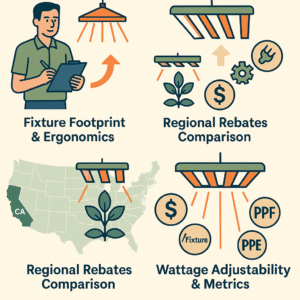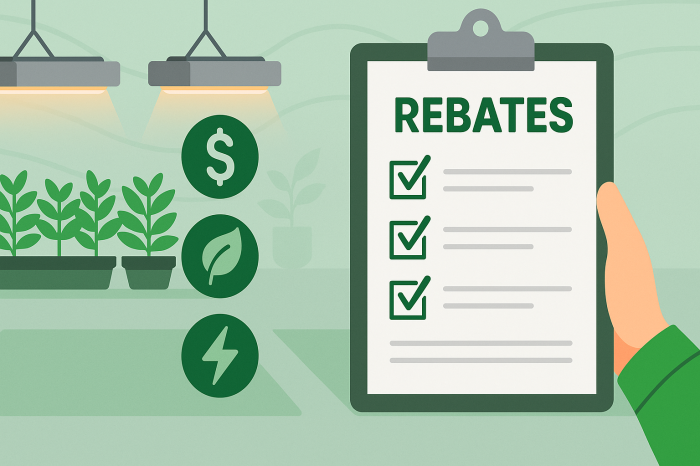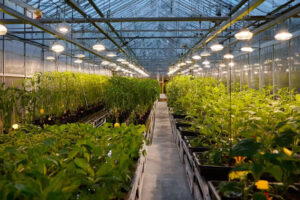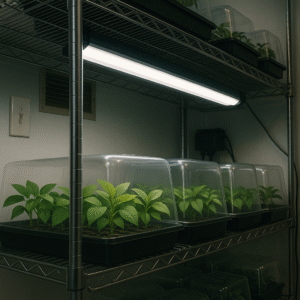
Great grow operations don’t just happen — they’re planned. With LED grow lights rebates, early strategy can make a big difference. Rebates lower upfront costs, improve long-term returns, and shape how your facility runs for years.
Partnering early with Grow Lights Rebate Solutions gives you an advantage. Their rebate specialists understand how utilities structure their programs and how lighting choices affect your payout. Smart moves now can save thousands later.
Choosing the Right LED Grow Lights
1. Light Footprint Size
Bigger fixtures often reduce costs. A single large light can cover more area with fewer parts. Over time, this can save on both purchase price and labor.
Why larger fixtures can make sense:
- Lower equipment costs: Fewer ballasts and power supplies.
- Faster installation: Less hanging and wiring time.
- Cleaner layout: Fewer cords and mounting points.
Covering one grow bench with one large LED grow light is often cheaper than using two small ones. Across dozens or hundreds of fixtures, that difference grows significantly.
2. Under-Canopy and Ergonomics
Daily workflow matters. Under-canopy lighting impacts how easy it is to clean and harvest. Choosing longer fixtures over multiple short ones can cut the workload in half.
Practical advantages:
- Less moving: Fewer lights to shift during harvest or wash-down.
- Fewer weak points: Fewer connectors to check or re-seat each cycle.
- Better protection: Locking waterproof connectors reduce water damage risks.
Fixtures from under-canopy LED grow lighting specialists are designed with these day-to-day realities in mind. Fewer connection points means less chance of missed clicks and broken plugs when time is tight.

Lessons from Commercial Growers
Real Experiences, Real Impact
Large cultivation sites share valuable insights after going through rebate programs. Many found that early lighting choices affected cleaning speed, future expansion, and even rebate tiers.
Common lessons include:
- Fixture size influences rebate amount and installation cost.
- Well-placed under-canopy lights reduce labor costs long-term.
Some operators even reconfigured their lighting to qualify for higher rebate tiers — proving that a little planning goes a long way.
Understanding Regional LED Grow Lights Rebates
California: Per-Fixture Programs
Some California utilities offer rebates based on the number of fixtures. Smaller LED grow lights can sometimes result in higher total incentives. Check PG&E Rebates & Incentives to see current per-unit payouts.
Key details:
- Incentives often vary by climate zone.
- Fixture type and DLC listing affect eligibility.
- Applications should match the exact fixture models used.
Michigan: Per-Watt Programs
In Michigan, Consumers Energy offers rebates based on watts installed. Bigger fixtures that deliver more light per unit can unlock higher rebates in a single installation.
Typical advantages:
- Larger lights can yield bigger single rebates.
- Simple layouts reduce the number of rebate line items.
- Higher wattage per fixture may be more economical overall.
Using Wattage Adjustability Strategically
Field-Adjustable Wattage
Some LED grow lights let you select different wattage levels. If these levels are DLC-listed, you can set lights to meet program targets.
Know the Metrics Utilities Use
Common Performance Metrics
Most rebate programs use a mix of these values:
- Total Watts: Installed power capacity.
- PPFD: Light reaching the canopy.
- PPF: Total light output.
- PPE: Light output per watt used.
California’s Title 24 Energy Code sets baseline lighting power allowances. Exceeding these baselines with efficient systems can increase your rebate amount.
Why this matters:
- Higher efficiency often equals higher incentives.
- Accurate specs make applications smoother.
- Good design can improve both rebates and yields.
Verification and Compliance
Why Utilities Double-Check
After installation, utilities often compare your actual energy use to your application. If it doesn’t match, they can adjust or reclaim rebates.
How to avoid problems:
- Submit accurate wattage and model info.
- Keep inspection settings realistic.
- Document everything from the start.
Start Early, Earn More
Key Takeaways
- Plan your lighting with rebates in mind from the beginning.
- Pick fixture sizes and wattages that fit your utility’s structure.
- Lean on experts and verified rebate resources for guidance.
LED grow lights are a big investment. Pairing them with smart grow lights rebate strategies can reduce costs, boost productivity, and future-proof your facility.









